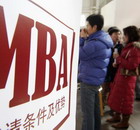Green China
Chinese wind power companies target global markets
(Agencies)
Updated: 2009-12-07 14:12
 |
Large Medium Small |
BEIJING: China's Goldwind Science & Technology Ltd is one of the world's biggest makers of wind turbines -- a cornerstone of the booming clean power business -- but is virtually unknown outside its home country.
Goldwind aims to change that. In a Minnesota farmer's cornfield, the company is erecting three 20-story-tall windmills in its first American project and hopes it will help to woo other buyers.
"There are a lot of leads and we are following them up," said Kerry Zhou, Goldwind's director of development. "We certainly expect that by 2011 we can get good results."
China's market for wind equipment is on track to overtake the US this year as the world's largest, spurred by a government campaign to promote renewable energy to clean up its battered environment and curb surging demand for foreign oil and gas.
Now the biggest Chinese manufacturers want to expand to the United States, Europe and other markets. Western suppliers could face new competition as Chinese rivals seek to profit from global efforts to limit climate change.
"China is a major player and will dominate the future development of wind," said Lars Andersen, president for China of Denmark's Vestas Wind Systems A/S, the world's biggest maker of wind turbines.
Chinese wind companies' technology lags behind global leaders such as Vestas and General Electric Co. But their prices are up to 50 percent lower, which industry analysts say should make them competitive abroad.
"The performance-to-price ratio is quite attractive," said Victoria Li, who follows the industry for Credit Suisse in Shanghai. "I think they could see strong growth from export revenue within two years."
Last year, China accounted for 22 percent of new global wind capacity, while the United States accounted for 29.6 percent, according to BTM Consult, a Danish research firm. This year, Credit Suisse says China will install up to one-third of new capacity.
The industry has gotten a boost from a flow of money through the Clean Development Mechanism, a UN program that allows industrialized economies to meet commitments to reduce greenhouse gas emissions by paying developing countries to cut their own instead. China is the biggest recipient of CDM money.
Chinese demand is so huge that with almost no foreign sales, Goldwind and rivals Sinovel Wind Co. and Dongfang Electric Co. already rank among top global manufacturers.
Sinovel, Goldwind and Dongfang together made one of every eight wind turbines sold worldwide in 2008, according to BTM. Vestas led global sales with 19.8 percent and GE was second with 18.6 percent.
Beijing-based Sinovel made its first foreign sale last year, shipping 10 1.5-megawatt turbines to India, said a company spokeswoman, Liu Chang. Also in 2008, Goldwind sold six of its smaller 750-kilowatt units to Cuba.
In Minnesota, Goldwind is installing three 1.5-megawatt turbines on a farm in the town of Pipestone. Zhou said the company hopes the site will prove its turbines operate reliably under US weather conditions.
In July, Beijing raised its wind power goal to 150 gigawatts of generating capacity by 2020 -- the equivalent of 300 standard coal-fired power plants -- up from the 2005 plan's target of 30 gigawatts.
But the industry faces technical hurdles to its growth.
Wind farm construction has raced ahead so fast that 25 percent have yet to be connected to the national power grid. Like the United States, China faces the problem that its windiest areas in the desert northwest and northern grasslands are far from populous cities, requiring expensive transmission lines.
Other companies are developing technology ranging from solar panels and fuel cells to more far-out systems that make power from garbage and used cooking oil.
China's solar cell producers have competed abroad in Spain, Germany and California since they got into the business early this decade because the technology was too expensive for Chinese buyers. The biggest, Suntech Power Holdings Ltd, is on track to pass Germany's Q-Cells SE as the world's top supplier as early as this year.
"In an incredibly short space of time China has taken the lead in the race to develop and commercialize a range of low-carbon technologies," said the Climate Group, a London-based environmental organization, in a report in August.











